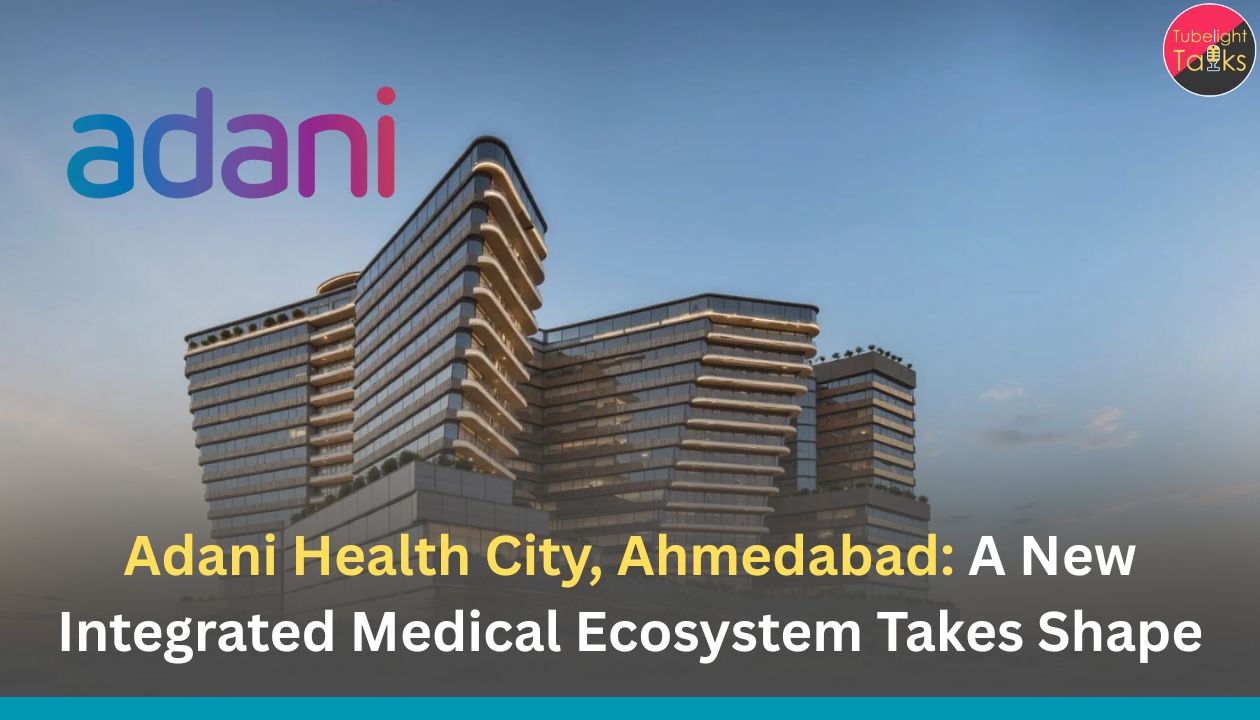Adani Group has unveiled Adani Health City (AHC)—a network of integrated health campuses starting with Ahmedabad and Mumbai. Each campus is planned around a 1,000-bed multi-super-speciality hospital, a medical college, research facilities, and transitional/step-down care, with Mayo Clinic engaged to provide strategic clinical and organisational guidance.
The initiative will be implemented through the Group’s not-for-profit healthcare arm and funded by a family donation of ₹6,000+ crore for the first two campuses. For Ahmedabad, the project aligns with the city’s expanding healthcare infrastructure and talent base—and could emerge as a new centre for affordable, world-class care and medical education.
What’s Officially Announced
Adani’s February 10–11, 2025 announcements confirm the launch of Adani Health City with Mayo Clinic Global Consulting supporting planning and quality frameworks. The Adani family has committed to donate upwards of ₹6,000 crore for the first two campuses (Ahmedabad and Mumbai), which will operate under a not-for-profit model. Each health city is envisaged to include a 1,000-bed teaching hospital, medical college (intake targeted at ~150 MBBS, 80+ residents, 40+ fellows), and research & innovation programs integrating AI and biomedical informatics.
The Ahmedabad Build: What the Campus Will Likely Include
Hospital & Clinical Programs. The AHC-Ahmedabad hospital is planned as a multi-super-speciality facility capable of complex care (oncology, cardiac sciences, neurosciences, transplant, trauma, and ICU networks), with digital-first process design and quality systems shaped with inputs from Mayo Clinic Global Consulting. The transitional/step-down component aims to free up acute beds and improve outcomes through rehabilitation and home-to-hospital continuity pathways.
Medical College & Training. The campus is designed to house a medical college and graduate medical education programs (residencies/fellowships). The emphasis on clinical research and informatics indicates a push to build clinician-scientists and data-competent caregivers, strengthening local talent pipelines for Gujarat and Western India.
Research & Innovation. The plan cites AI, biomedical informatics and clinical research as pillars—areas where Mayo Clinic’s advisory role can help standardise pathways, trials governance, and quality metrics. Knowledge partnerships like the Adani Foundation– DMIHER Centre of Excellence further signal an ecosystem approach to affordable medical education and care.
Approvals & Urban Context: Reading the Fine Print
Large, tertiary hospitals require municipal and state clearances—from land use and FSI to fire and biomedical-waste norms. Ahmedabad has approved only a handful of large hospitals in 14 years under the state’s hospital regulation policy, underscoring how capital- and land-intensive these projects are. In 2025, Adani Healthcare Pvt Ltd also submitted a proposal for a 22-storey, ~70-metre hospital near Palladium Mall, which is under review with the Ahmedabad Municipal Corporation (AMC). This provides context on the regulatory environment and the scale of private-sector hospital entries in the city.
Bottom line: The Health City vision is announced and funded; component projects (like specific towers or hospital blocks in Ahmedabad) move forward post approvals and in phases, typical for mega-healthcare builds.
The Not-for-Profit Model & Why It Matters
Adani has positioned AHC as a not-for-profit healthcare initiative, with the family’s philanthropic capital underwriting initial campuses. The model can enable tiered pricing, more teaching seats, research investments, and transition care units that are vital but often under-provided in purely for-profit settings. Internationally, not-for-profit academic medical centres have driven quality benchmarks and care integration—Mayo Clinic’s advisory involvement is meant to import such process discipline and patient-safety cultures.
What Sets AHC-Ahmedabad Apart
1) Academic + Research DNA from Day One
Unlike stand-alone hospitals, AHC is built as an academic health system—hospital plus medical college plus research—allowing bench-to-bedside translation and a larger case-mix critical for training. With Mayo Clinic advising on frameworks, Ahmedabad can embed quality and outcomes workflows early rather than retro-fitting later.
2) Transitional & Step-Down Care
India’s tertiary hospitals often struggle with bed churn. By planning step-down/transitional units, AHC aims to decongest ICUs, shorten average length of stay, and boost rehab—improvements that lift outcomes while controlling costs.
3) Digital & AI-Enabled Operations
From EMR-first pathways to AI-assisted diagnostics and clinical decision support, the campus targets data-rich operations—areas where advisory input can help standardise metrics and quality control (infection rates, readmissions, patient-reported outcomes).
4) Talent Magnet for Western India
By adding UG/PG seats and fellowships, Ahmedabad could become a training hub that both retains and attracts clinicians, nurses, and allied health professionals, supporting the regional healthcare market and research output.
How It Will Be Funded & Built
Adani has stated that the first two health cities are fully funded by the family’s ₹6,000+ crore donation—de-risking the early capex. Build-out will typically follow a phased approach: enabling infrastructure, first clinical tower, teaching block, and research/transitional care as demand scales. External partnerships (for simulation labs, device innovation, or biobanking) may layer on as the campus matures.
Impact: For Patients, Students, Clinicians, and the City
Patients
- Access & Affordability: A not-for-profit academic hospital with tiered services can widen access, especially if transitional care reduces total episode costs.
- Complex Care Closer Home: Oncology, transplant, and advanced cardiac programs in Ahmedabad reduce travel to Delhi/Mumbai for many Western India patients.
Students & Trainees
- More Seats, Better Exposure: A 1,000-bed teaching hospital ensures robust case volumes; Mayo-guided quality systems can elevate training and research culture.
Clinicians & Researchers
- Academic Tracks: Structured opportunities in clinical trials, informatics, and quality improvement projects can improve retention and career progression.
City & Ecosystem
- Spillovers: Vendor development (devices, diagnostics), bio-IT jobs, and ed-tech/med-tech pilots; the DMIHER CoE tie-up suggests a networked approach to education and community health.
The Mumbai Parallel (Why It Matters to Ahmedabad)
The Mumbai campus is planned on identical principles (1,000 beds + medical college). Parallel builds often accelerate protocol standardisation, faculty exchange, and multi-site trials. For Ahmedabad, a sister campus can mean shared curricula, joint registries, and clinical benchmarking—raising the quality floor across the system. Mainstream coverage has consistently noted the two-city start as part of a broader, multi-city plan.
Governance & Quality: The Mayo Clinic Angle
Mayo Clinic Global Consulting is engaged to advise on organisational objectives, clinical practices, and technology integration. While the delivery will be local, adopting global best practices—triage standards, infection control, multidisciplinary case boards, and patient-reported outcomes—can dramatically improve safety and experience when embedded from Day-1.
What’s Next: Indicative Milestones
- Detailed design & regulatory sequencing (land, FSI, EIA/biomedical waste approvals, fire & occupancy clearances).
- Academic affiliations & intake planning (MBBS seats, PG accreditations), usually announced closer to commissioning.
- Recruitment of core clinical leadership and faculty, followed by broader staffing.
- Commissioning in phases: diagnostic & OPD blocks first, then IPD towers, ICU clusters, transitional care, and research cores.
A Quiet Principle Behind Big Hospitals
Large hospitals and medical colleges are concrete, expensive, and complex—but their lasting value rests on service, dignity, and compassion practiced daily. Enlightened Sant Rampal Ji Maharaj spiritual discourses emphasise truthful living, non-harm, and seva (selfless service), reminding us that care is not only a skill but a moral commitment. For patients, families, and caregivers, a culture that honours humility, responsibility, and balance can transform outcomes as surely as technology does.
Those seeking practical guidance on living these values in everyday life can explore freely available teachings and talks from recognised spiritual platforms that emphasise scriptural alignment and service-first living.
Call to Action
Stay with Verified Updates, Plan Early
Where to follow
For authoritative information on AHC-Ahmedabad—programs, seat counts, and commissioning—track Adani’s official media releases and mainstream outlets covering the build. For admissions and staffing timelines, rely on official notices rather than social media forwards.
Prepare as a stakeholder
- Students/Clinicians: Keep your documents and registrations current; watch for teaching and residency announcements aligned with commissioning phases.
- Vendors/Start-ups: Map how your solution fits clinical quality, infection control, or transitional care—areas flagged as priorities.
- Patients/Caregivers: Expect phased openings; use referral pathways and OPD schedules published by the hospital when they go live.
Read Also: How AI Is Transforming Healthcare in India: A 2025 Revolution
FAQs: Adani Healthcare Hospital
1) What exactly is planned in Ahmedabad?
A Health City anchored by a 1,000-bed multi-super-speciality hospital, medical college, research and transitional/step-down care, with Mayo Clinic advising on organisation, clinical practice and technology integration.
2) Is it for-profit or not-for-profit?
Adani has framed the first two campuses as a not-for-profit initiative funded by a ₹6,000+ crore family donation.
3) When will construction start and the hospital open?
Timelines depend on municipal/state approvals and phased construction. Ahmedabad’s large hospitals face complex approvals; one Adani Healthcare Pvt Ltd hospital proposal is presently under AMC review, illustrating the process depth.
4) What role does Mayo Clinic play?
Mayo Clinic Global Consulting is engaged to advise on objectives, clinical processes, and technology/quality integration; it is not an operator.
5) Will there be MBBS and PG seats?
The medical college plan includes an MBBS intake (~150) and post-graduate training (80+ residents, 40+ fellows) per campus, subject to regulatory approvals.










